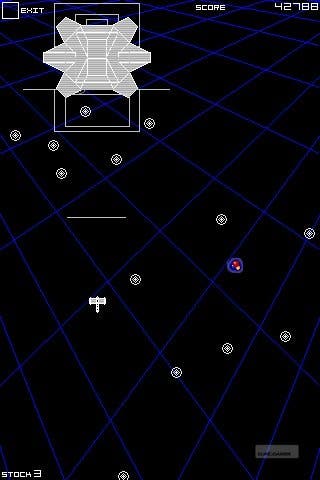Space Invaders: Infinity Gene
Made of Darwin.
The answer is: incrementally. By choosing the evolution of the shoot-'em-up genre as the game's core theme, each stage is able to move one step further away from the original's template. By World 2, colour is introduced, scarlet red backgrounds implying the battle's taking place over a Tron recreation of Mars. By World 3, whole sections involve no shooting at all, instead taking the form of Radiant Silvergun-style labyrinthine mazes with opening and closing doors through which you must nudge your ship. Every time you complete a level or post a new high score, a gauge fills. Once full, a new evolution is triggered, unlocking an extra stage, a new weapon or some other additional extra that, mutation by mutation, grows the game out from its original form in fascinating ways.
But all of this structural cleverness would be for nothing if the game Space Invaders was becoming were no good. Mercifully, it is beyond good. The journey from what was, to what is, to what is to come is nothing short of a revelation. While originally designed for Japanese mobile phones, in Apple's iPhone Infinity Gene has found its true home. Your ship auto-fires constantly, ensuring full concentration can be placed on manoeuvring it through the maze of bullets and obstacles and lining up shots. As you can touch any part of the screen to move your craft around, you'll never obscure your view, allowing for precise control even in its busiest stages.
The camera has been drawn far back from the action too, your ship just a few pixels wide, ensuring that the environment never feels cramped. By choosing to keep all of the game's sprites as monochrome blocks, the sense of coherency with Space Invaders universe is maintained, without compromising the newfound freedom its evolutions have brought. The result is a game that feels like its been blocked out with architectural schematics in preparation for final textures. Late in the game, a giant ladybird boss appears as nothing more than a large horizontal diamond, its four extendable legs represented by thin vector lines that expand and retract, giving the impression of a bug straddling the screen and ascending and descending its sides. This simplistic, cubist approximation of the monster's appearance does nothing to lessen its impact, instead highlighting the logic and drama that, beneath the graphics and textures, underpins all games.

Still, while the vector lines pack a considerable minimalist aesthetic punch, there are drawbacks to the approach. There's nothing to distinguish your bullets from those of your foes, as both are rendered in powder white lines (where usually one would be, say, red and the other blue) and, when the on-screen action becomes busy, it can be hard to distinguish between bullet and bulk, or to discern whose is whose. While the economy of detail in the visual approach allows a large number of moving items on screen at once, oftentimes the iPhone strains under the pressure of pushing so many pixels at once, and the slowdown is too frequent and too persistent to be overlooked as retro chic charm.
Once the game's core 38 stages are exhausted, and high scores set and broken, the music mode provides near infinite potential for ongoing play. Making use of firmware 3.0 update, which for the first time allows developers to extract song data from the device's music library, the game will generate levels from any song on the handheld. The level construction remains the same every tie you return to a particular song, and will be consistent across all iPhones. This means you can challenge a friend to a game of Space Invaders: Mahler's Symphony Number 5, and the level will be identical for both of you, a thoughtful touch that extends the product's life as well as its relevancy amongst groups of friends.
Space Invaders: Infinity Gene heaves and grows through infancy to maturity. It's rare that a game builds into its play arc those design iterations it went through from inception to completion. Yet this is exactly what Taito has achieved: leading players from beginning to end, providing a mesmerising journey through both the game and its genre's conceptual history. The result guarantees the future of its series, its inevitable popularity bringing this once household name to a new generation of players. And in terms of the series itself, Infinity Gene is its crowning achievement. Of all the Space Invaders it's the most adaptable to change, for sure. Contrary to Darwin's expectations, it's also the strongest and most intelligent.
